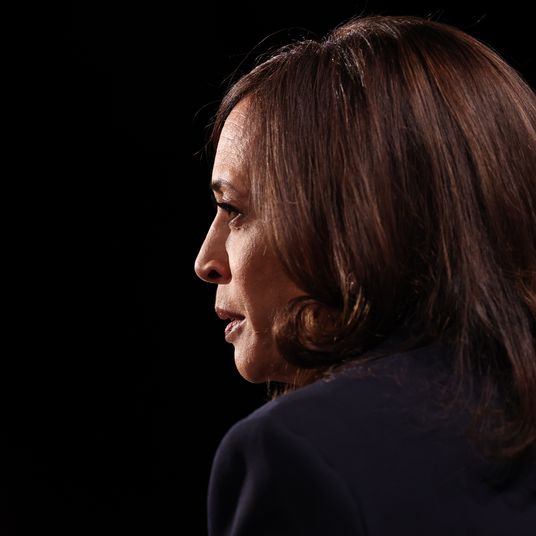
From the moment Vladimir Putin ordered his troops into Ukraine, political observers have wondered whether the conflict might pull Joe Biden’s presidency out of the slough that has afflicted his job-approval ratings and depressed Democratic prospects for the 2022 midterms. Biden used last week’s State of the Union address to attempt to “reboot” his presidency with a rally-round-the-flag effect, some positive news about economic growth and employment, and a fading Omicron surge all contributing to a narrow window for a fresh start.
There’s now enough post-invasion and post–State of the Union polling out there to provide some evidence of a “Biden bounce” in job-approval ratings, though it’s at best pretty modest. The bigger question is whether events still on the horizon will reinforce or reverse the slight improvement of the president’s standing before voters judge him and his party in November.
One thing is clear: Recent events have at least arrested what had been a steady slide in Biden’s job-approval numbers over many months. According to the comprehensive and partisan-bias-weighted FiveThirtyEight polling averages, the president’s job-approval ratio went “underwater” (net negative) on August 30, 2021, at 47 percent positive and 47.2 percent negative. Biden’s popularity continued to deteriorate slowly but surely with his approval rating hitting bottom at 40.4 percent (with 53.3 percent disapproval) on February 27, three days after Russia invaded Ukraine and two days before the SOTU address. Now his approval rating has inched up to 42.7 percent (with 51.4 percent disapproval). To put it in a comparative context, Donald Trump’s job-approval ratio, per FiveThirtyEight, was slightly worse (40.6 percent approval to 53.6 percent disapproval) at the same point in his presidency.
Digging into the polling, two post-SOTU surveys showed significant improvements for Biden; his approval rating was up eight points in a Marist poll and three points in a Morning Consult poll. Even better, they showed Biden’s bump extending across the board, from Democrats to independents to Republicans, with an equally impressive boost in the president’s approval rating for handling the Ukraine-Russia situation. It has all the hallmarks of a “rally around the flag” bump, which in situations not involving U.S. troop deployments or an attack on the United States is usually temporary in nature. Even in the Marist survey, which gave Biden an overall 47 percent approval rating, he was still well underwater in approval of his handling of the economy.
What does this limited data suggest for the road ahead? Well, you can pretty much ignore tiny improvements in Biden’s extremely low standing among Republicans; by November, that number is likely to be even lower, and even those expressing appreciation for him today may not actually prefer Democratic candidates for Congress or state offices. Barring some disaster or an intensification of the intraparty divisions surrounding the late lamented Build Back Better legislation, Biden’s popularity should continue to improve with Democrats as Election Day approaches; the question among Democrats is all about intensity and willingness to turn out to vote rather than party preference.
But Biden’s standing among independents — especially true indies who are not de facto partisans — is worth watching closely. Biden won independents by any measurement in 2020, as Ron Brownstein notes. But now, “in CNN polling, Biden’s standing with independents is only slightly above the lowest job approval the survey ever recorded among them for Trump (31%) or Obama (32%).” Depending on whom you believe, these people represent somewhere between 7 and 14 percent of the electorate, though the percentage in midterm elections is almost certainly lower. In close, hyperpolarized contests, they still matter, sometimes a lot. The easiest way for Biden to recapture some independents, of course, involves improvements in actual and perceived conditions in the country, particularly COVID and inflation. But some would argue the less “transformative” rhetoric he displayed in the State of the Union Address will also help, and almost everyone agrees that finding a way to refocus voters’ attention on things they don’t like about Republicans (a very difficult task in midterms) is even more important. The two key avenues for doing that are no secret, as Brownstein observes:
Even as the GOP majority on the Supreme Court nears a decision that could overturn Roe v. Wade and Republican-controlled states race to impose new limits (or effective bans) on abortion, a January CNN poll found that nearly three-fourths of independents want to maintain the constitutional right to the procedure.
And then there’s the 45th president, who is incapable of staying out of the news:
For one thing, he remains about as unpopular among independents as Biden is. For another, he remains unusually visible, pressing his unfounded claims of fraud in the 2020 election, touting his admiration for Russian President Vladimir Putin amid the Ukraine invasion and confronting continued revelations about his campaign to overturn the election’s result, which culminated in the January 6 insurrection at the US Capitol last year.
The question we really can’t answer now is whether future developments in Ukraine will help or hurt Biden’s popularity. Short of an outright Russian defeat or the deployment of U.S. troops, it’s not easy to envision a trajectory of events that will greatly affect Biden’s standing. The short-term economic fallout is likely to be negative; if it’s very negative, and Biden fails to make a Churchillian appeal for sacrifice, it could make it very hard for him to recover popular support for the most important “real life” indicator, particularly among independents.
What we do know is the party controlling the White House almost always loses ground in the midterms except for rare occasions where the president was unusually popular. And even if Biden’s job-approval rating stabilizes or modestly improves, he’s a long way from what he’d need for his party to triumph in November. As Vox’s Andrew Prokop recently put it:
The historical pattern is clear, and ominous for Joe Biden and Democrats this year: The president’s party usually does poorly in midterm elections.
“It’s not quite a law of physics, but it’s probably as close as you’re going to get in the social sciences,” says Carlos Algara, a professor of political science at Claremont Graduate University.
On the two occasions since 1934 when that near law of physics has been broken, the president in office had job-approval ratings above 60 percent. In 1962, John F. Kennedy had an approval rating of 61 percent, and Democrats still lost four House seats, which happens to be exactly the maximum number of seats Democrats can afford to lose in November without losing the House and their governing trifecta.
So even with the modest good news Democrats have been given in the redistricting process, they will need a lot more than a “bump” in Biden’s approval ratings to overcome history and logic. Yes, stabilizing and marginally improving Biden’s popularity can place a floor on Democratic losses and perhaps (with some luck and a lot of Trump-fueled Republican stumbling) even save the Senate. But the blunt truth is that barring a dazzlingly successful Biden presidency — one that extends his popularity beyond his party deep into the ranks of independents and even Republicans — Democrats have already lost. They sealed their fate in November 2020 when they carried the House by such a surprisingly small margin. Nothing Biden has done right or wrong since then has changed that fundamental reality.
More on the Midterms
- Are Democrats the Party of Low-Turnout Elections Now?
- New Midterms Data Reveals Good News for Democrats in 2024
- The Return of the Emerging Democratic Majority?






























